

Christopher Miller - NanoJapan 2014
University of North Carolina, Chapel Hill
Major: Physics & Japanese
Class Standing: Freshman
Anticipated Graduation: May 2017
NanoJapan Research Lab: Oda - Kawano Lab, Prof. Yukio Kawano, Tokyo Institute of Technology
NanoJapan Research Project: ![]()
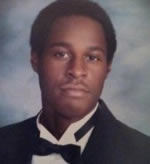
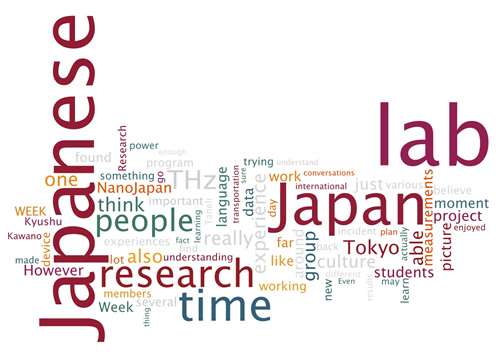
Why NanoJapan?
To me, the NanoJapan Program is critically important to engineering and physics students interested in science because it allows them to pursue academic research in specific areas of science that interest them while also exposing them to various aspects of Japanese culture. I believe that it is imperative that people, regardless of their primary academic interests, have a thorough understanding of different people and their cultures. If people do not have an adequate understanding of diverse cultures, then there will persist to be cultural barriers that separate them from these diverse people. This is especially important for scientists because today’s scientific community is no longer homogenous and requires that diverse groups of people work alongside each other in cross-cultural settings. The NanoJapan Program is unique because it aims to expose and educate engineering and physics students to Japanese culture while also giving them the unique opportunity to perform research in an international setting. I personally applied to the NanoJapan Program in the hopes of being able to experience this. Since a young age I have always been fascinated by Japanese culture and have hoped to learn more about it in both a traditional and a modern sense. In addition to this, I am spurred to learn more about and the abstract concepts that govern the world around me through studies in physics. The opportunity to combine science and culture in the NanoJapan Program is a very unique experience that will be an enlightening part of my undergraduate studies. The NanoJapan Program will highlight and expand upon both of my undergraduate academic interests consisting of majoring in physics and Japanese.
From an academic perspective I hope to be able to identify and experiment with a new type of scientific research that excites me during this program. At the moment I am very interested in learning more about various terahertz imaging techniques and hope to be able to experiment with them. If this is not the case however, I will be equally satisfied with another form of nanotechnology research that piques my interest. I also hope to be able to acquire moderate proficiency in speaking and translating Japanese during my time in the program. In regards to Japanese culture, I aim to learn more about traditional aspects of Japan. I am fascinated by Japanese history and cultural traditions and would love to be able to visit areas that still present traditional aspects of Japan.
My goals for this summer are to:
I honestly expected to feel a surreal sense of culture shock as soon as I landed in Japan. Prior to arriving, I thought that I would notice everything that’s different about Japan as soon as I stepped off the plane and would be overwhelmed by the experience. Much to my surprise however, this expectation was far off from what I actually experienced. To be honest, once I got off the plane in Japan and waiting around in the airport, I didn’t really feel any different. Aside from the gradual realization that I couldn’t use English to speak to whomever I wanted to, it didn’t really feel any different. Perhaps my experience was like this because I was already aware of several similarities and differences between American and Japanese society prior to arriving and had anticipated a few of the cultural aspects of Japan that I would encounter. Even now I have yet to pick up a lot of differences that exist between American and Japanese society. Honestly, I am worried that I am failing to learn more about Japanese culture because I have not picked up on key differences amongst the two countries. Perhaps I need to pay a little more attention to my surroundings each day.
In regards to the Japanese language classes, my experiences with them have all been positive. I actually think the classes are somewhat fun. As far as learning strategies, I have found that it really helps me to think in Japanese often (a habit that I picked up while learning and memorizing Spanish). I think it’s a good strategy for retaining a language. Lastly, one question that I have about Japan is regarding socializing in Japan. What’s a good way to go about meeting or introducing myself to new people? By this I mean meeting people in everyday settings. I’m open to speaking Japanese with people but I am not sure how to go about it if I wanted to start a casual conversation on the subway, etc. Perhaps this is a questions better suited for KIP students…
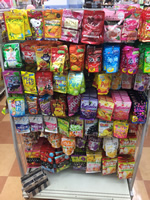
Experimenting with Japanese Candy: This is just a picture of a lot of Japanese candy that I found in a Daiso Store (100 Yen Store) in Harajuku, Tokyo. I’m a huge fan of Japanese candy (esp. gummies) and bought a lot of candy to take back to the Sanuki Club Hotel that night. Since I arrived in Japan I’ve been on the lookout for candy stores.
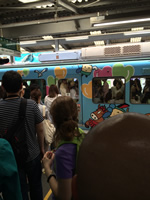
Exploring All of Tokyo: A group of us who were going to Kamakura found this really interesting train on the way there. Even though it’s only been a week, I’ve done a lot of travelling throughout Tokyo and thought that this picture should be here.
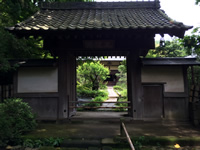
Learning About Japan's History and Traditional Culture: This picture is from one of the temples that we visited during our time in Kamakura. I’m really interested in Japanese history and culture so I enjoyed going to Kamakura and seeing the various shrines and temples. I’m hoping that I’ll be able to go to Kyoto as well so that I can learn more about Japanese history and do some more sightseeing.
Intro to Nanoscience Lectures: In his lectures, Prof. Bird introduced us to basic concepts and techniques that are present in semiconductor bandgap engineering and also explained the importance and properties of graphene in relation to nanoelectronics. Through the lectures we were introduced to the properties of semiconductors in greater detail and examined the existence of forbidden band gaps and their importance to bandgap engineering. After being exposed to bandgap engineering we were introduced to the unique properties of graphene that make it ideal for nanoelectronics applications, its current complications in implementation, and future work being done in relation to the use of graphene in nanoelectronics.
In the other lectures throughout the week we were also introduced the properties and potential applications of carbon nanotubes by Maruyama-sensei and the use of electrons in ARPES by Ishizaka-sensei. I found Maruyama-sensei’s lecture on carbon nanotubes to be particularly interesting because it really helped me to further understand what carbon nanotubes are and their uses for nanotechnology applications.
Overview of Research Project at the Kawano Lab, Prof. Yukio Kawano, Tokyo Institute of Technology
From my current understanding, I will be working on two different projects during my time with the Kawano group. For the first project I will be continuing an ongoing project being done in the lab under the guidance of Naoki Fujimura. For this project I believe I will be helping to gather data from experiments regarding the creation of a “powerless, compact, broadband, flexible, large-area, and polarization-sensitive” carbon nanotube terahertz detector 1. Thusly, an important material that we will be using for this project will be carbon nanotubes which have the characteristic dimensionality of a 1D system. The actual carbon nanotubes that are being used for this project are a mixture of both semiconducting and metallic types. However, I am not sure if the nanotubes being used in this project have any special intrinsic properties aside from some of the advantages of carbon nanotubes which consist of their ability to absorb a THz radiation across a wide spectral range, electronic flexibility that can be achieved via doping, “mechanical strength and flexibility, and extreme electromagnetic anisotropy” 1. Furthermore, for this project, we will primarily be examining thermal, electrical, and optical properties of our system. The project that we will be pursuing has the potential to be applicable in a wide variety of fields ranging from medicine to defense. One reason that we will be pursuing this project is that there is a lack of “compact, efficient, and room-temperature operating devices” that can generate and detect waves within the frequency range of 0.3 and 3 THz(He, Xiaowei, et al. "Carbon Nanotube Terahertz Detector"). For the second project I will be learning more about near-field THz imaging techniques but am currently not sure about all of the details regarding that project at the moment.
During my time in Japan I have noticed quite a few unspoken rules that exist on the subways and railcars. Although it has only been two weeks, I have already spent a lot of time traveling throughout Tokyo via railcar and subway. For instance, I have noticed that people on the subway tend not to talk to each other while on riding public transportation. Throughout my time on Japanese public transportation I have rarely heard people carrying on conversations that I can hear from a short distance away. In most cases, the people are usually talking very quietly to someone who is right next to them. For instance, while coming back to Haneda airport I noticed that a man who was talking on the cell phone made sure to cover his mouth and talked very quietly so that he would not disturb the other people around him.
The most common activities that I have observed people riding public transportation engage in are reading a book, doing something on their phone, or playing a handheld video game system (usually a Nintendo 3DS). I don’t think I have observed people in engaging in other activities as often.
One thing that I really like about Japan’s public transportation system is its efficiency. Although I haven’t ridden public transportation in America often, none of my experiences with it have been as good as my experiences with Japanese public transportation so far. Usually if I want to go somewhere via public transportation in America I have to do a significant amount of planning ahead of time about how I will get there. This research usually includes estimating my budget expenses, memorizing the routes, etc. Of course, this experience of mine results from living in a small suburban town in America. What I have observed in Japan is that the public transportation is far easier to navigate (once you take the time to learn how it works), more efficient, and far more accessible than what I have seen in America. This difference is certainly practical in its nature.
From these observations I think I can say that within Japanese culture, there is an ever present concern about the well-being of others and a desire to maintain harmony by not infringing upon their well-being. I am inferring this from the quiet and calm atmosphere that I have observed on public transportation in Japan. Regardless of whether or not the train is almost empty or crowded, people tend to respect the well-being of others by not having loud conversation or inconveniencing others by their actions. Perhaps that is why most of the activities that I have observed on the train are quiet activities that one can partake in by his or her self. I believe that the concept of harmony within Japanese culture that was presented during the pre-departure orientation is maintained in Japanese society through these actions.
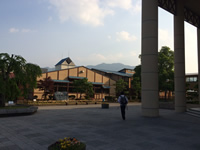
Gokase School in Kyushu: This picture is just a quick photo I took of Gokase Secondary School in Gokase-cho, Miyazaki. I chose this photo in particular because my entire experience in Japan last week was characterized by my experience in Kyushu. I really enjoyed meeting the Gokase Secondary School students and also a few new KIPP students. Going to Kyushu and meeting all of the new people was definitely a highlight of my experience in Japan. (See Week 3 for more about the Kyushu Trip)
The Kyushu trip was a very enjoyable experience. While we were in Kyushu I spent a lot of time appreciating the nature and the landscape. Accordingly, I took a lot of pictures of the scenery of the various towns and places that we went to. Going to Aso-san was another enjoyable experience of the trip; it’s a shame that we had to leave early though. Out of all of the things that we did in Kyushu, I think that meeting the Gokase high school students was one of the highlights of the Kyushu trip. I am not sure why I but really liked being able to just talk with them. Even if we weren’t doing anything, I enjoyed talking to them. Much to my surprise, the Gokase students were much better at English that I had expected. I found that they spoke much better English when we having casual conversations during lunch, visiting shrines, or making waraji.
The next highlight of the Kyushu trip was the homestay family experience. My homestay family was very nice and hospitable. Although we did not have extended conversations, I enjoyed just being around them. During my time with my homestay family we had a Japanese barbeque and Osaki-san, a KIPP student, and I went to an onsen. The Japanese barbeque was probably my favorite part of the homestay experience. It’s a little difficult to choose between the barbeque and going to an onsen; they were both fun experiences. One of the biggest challenges for me during the homestay was always being conscious of how I should do things. There were several times when I wasn’t sure if it would be culturally appropriate for me to do or say something. I made sure to ask if I wasn’t sure but it definitely required effort on my part to be continuously aware.
As far as a reflection of Japanese cultural values through my homestay family, I noticed on several occasions that when Osaki-san and I offered to help Okaasan, she refused. For example, when my host family was preparing the tatami room that Osaki-san and I slept in, they tried to move a large wooden table by themselves. Given that they are elderly, we offered to move the table for them. Much to my surprise however, Okaasan refused our offer and tried to move the table again. However, she didn’t move the table and went into another room to do something else. While she was gone Osaki-san and I quickly moved the large table without letting her know; it was as if we had to go behind her back just to help her. I found this experience to be rather interesting. Perhaps it represents a Japanese cultural value of trying not to burden others with tasks. Perhaps Okaasan did not tell us to move the table (even if she wanted us to) because she thought that it may be a burden to us. In conclusion, maybe something that I can take from this experience is that “no” in Japanese culture doesn’t always mean “no”, in an American sense, and may be substituted by more subtle speech, gestures, or actions.
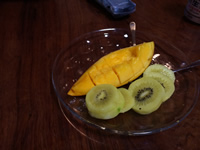
Fruit: This photo shows a few pieces of a Kyushu mango and a Kyushu kiwi. After eating a large feast outside, my host family, Osaki-san, and I had dessert inside the house. The food was amazingly delicious and I can still remember the tastes of the various foods that I ate that night. Okaasan made this delicious dessert and I will certainly miss it while I am gone.
Orientation Program Reflection
All in all, I enjoyed the orientation program in Tokyo. Once again, I think that the Kyushu trip was the most helpful to my experience and learning in Japan. The Kyushu trip allowed me to practice my Japanese, meet new people, and learn more about traditional Japanese culture all at the same time. I just wish that it had been longer than a weekend.
As far as learning the language I found that the following three strategies are very helpful:
Now that I have settled in my housing arrangements for the research period I can say that the most important thing that I have that I didn’t have back when I first arrived in Japan is internet in my room. It’s an amazing resource to have in your room whenever you need it. After living without internet in my room for three weeks, I still find it hard to believe that I have Ethernet right in my room.
Much to my surprise, my first day in the lab was actually very relaxed. I expected to be bombarded with a wealth of information to learn and memorize before doing research experiments and anticipated my first day as being somewhat hectic. However, this is far from what actually happened. Since I decided to meet with my graduate student advisor early on Sunday morning I spent most of my time on Sunday talking with him another member of the lab. After helping me check into my student housing, we travelled around Hiyoshi and Ookayama for the majority of Sunday afternoon. So, by the time I actually met the rest of the lab, I was not overwhelmed by this new encounter.
Basically, on my first day in the lab I was introduced to my cubicle (which I am still trying to furnish with things that represent me), met most of the members of the lab, and ate lunch with a group of students in the lab. All in all, I really enjoyed my first day in the lab.
At the moment I have two mentors, Fujimura-san and Hirano-san. They are both nice and very helpful. As far as the other people in the lab there are several people that I try to speak with regularly. Given that the lab is a big group and the position of my cubicle, I make an effort to speak with the people around me each day. Even if it’s just a simple “How are you?” I try to say something each day. Fortunately, I have had a few long conversations with the people in the lab. Most of the time we end up talking more when we go out to lunch together.
Quite a bit of English is spoken in my lab. Most of the time the students in the lab who are not Japanese speak English. However, most of them are fluent in Japanese as well. Other than that, a few other members in the lab speak English sometimes. The amount of English that people use in my lab is very situational. At this moment I do not believe that my current level of Japanese will hinder my productivity in the lab. If anything, I’m more concerned about whether or not my level of Japanese is good enough for me to interact with and socialize with the other members in the lab effectively. Therefore, I am working on improving my Japanese conversation skills.
Simply put, I love my housing. My housing arrangement is a college dorm named Hiyoshidai that essentially knows how to make life for a student as efficient as possible. Everything I could possibly need is located in Hiyoshidai. There’s a cafeteria, convenience store, weightlifting room, and public bath located on the basement. The housing also has parking for bikes, postal service, study rooms, and high speed internet in every room. As far as transportation to my lab, I just take the subway each day. The Hiyoshi subway station is a three minute walk from Hiyoshidai and the ride to Ookayama from Hiyoshidai is about 15 minutes and does not require any detours. So, all in all, it is very convenient for me.
At the moment I have not begun working on my research project. However, I have been attending weekly research meetings and learning about the procedures in the lab (e.g. how to start an experiment, safety precautions, etc.). Starting tomorrow, I will be participating in lectures as well.
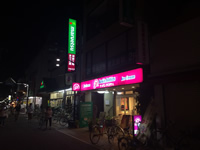
I found this familiar ice cream shop while I was walking around Kawasaki City, Kanagawa. Walking around aimlessly in Japan has its benefits and is something that I have been doing quite a bit lately. No worries though, I always remember how to find my way back. This picture just shows the various things that you can find walking about.
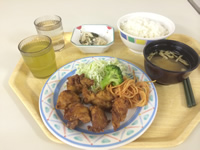
This picture is a dish from the dining hall in Hiyoshidai. I have had this dish several times and it is one of my favorite dishes. Since I have a meal plan for each day, I’ve decided to try every dish on the menu at least once. The food is delicious and is definitely something that I am going to miss when I have to leave Japan.
Perhaps the best cross-cultural communication experience that I can recall at this moment is the incident that occurred in a restaurant in Asakusa during the orientation program in Tokyo. The gist of the incident was that a group of Japanese relatives and friends were eating together at a restaurant celebrating a woman’s birthday. Simply put, the incident began with a bottle of wine being knocked out of a chair and breaking on a floor. This occurred at the exact same moment that we were entering the restaurant in our admittedly large group of people. There is a lot of speculation as to how the bottle fell exactly but one perspective was that one of the members of our large group knocked over the bottle of wine. Even now there is no clear indication of how the incident occurred. Subsequently, the family became upset at the incident and ultimately the police were called to the restaurant to resolve the situation.
A few days later we, the NanoJapan students, had a discussion with Packard-sensei about the incident. To me, the most meaningful cultural differences were highlighted and brought to my attention during this discussion. Amongst the various reasons as to why the group of Japanese relatives and friends became upset, one particular reason stood out to me. I remember Packard-sensei mentioning that the family was bothered by the fact that after the incident occurred, no one seemed to even notice what had just happened. Simply put, it seemed to them that we did not even acknowledge their loss, let alone the incident that occurred as we were passing by. I was genuinely surprised to learn that this, amongst other things, was a reason as to why they became even more bothered by the incident. In America, I believe that people are usually taught not to get involved in situations that they had no part in. Henceforth, many of us, myself included, chose to “look the other way”. Given this mindset, we decided that we could prevent the incident from becoming worse by not getting involved if we as individuals were not directly linked to the incident. This mentality also may have lead some of us to think that if we were not responsible for the incident then we should not, let alone even have the right, to apologize for what happened. Unfortunately, by doing this, the situation actually became much worse.
During the discussion we also reflected upon ways to handle this kind of situation if it were ever to occur again. To me, the most important thing that was mentioned was the ever present sense of group cohesiveness in Japanese culture. If we had been using this perspective, then perhaps we could have altered the outcome of that event somehow. The solution to a situation such as this may involve being more understanding of how our actions, not just individually but also as a group, affect those around us or simply apologizing for the actions of one of the members of our group. Of course, a multifaceted issue such as this could require a completely different type of solution. If anything, this incident served as a wake-up call to the cultural differences that were exchanged in our communication and interaction with the group of Japanese relatives and friends.
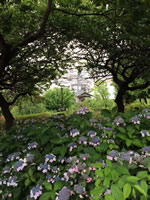
This picture here is from one of my weekend excursions around Japan. This picture is from Hiyoshi Park. During my free time I took the time to walk around Hiyoshi, Yokohama and found this park. During my time here I plan to visit several more parks scattered around Japan.
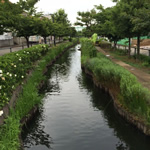
This is a picture from my weekend trip around Japan. While I was walking around Japan I ended up walking to Takatsu-ku which is one of the wards in the Kanagawa prefecture. After walking around for about an hour and a half I ended up in Kawasaki. I really like this picture because it showcases one of the many reasons I like Japan. Even in the middle of the city, one can find this beautiful river that continues for several hundred meters flowing through the city. I just admire the preservation of nature that this picture showcases.
I suppose the only ‘rules’ that I have consistently observed are those established by the hierarchy system. Obviously, people tend to refer to their seniors as either –san and in the case of professors, -sensei. Other than that, they refer to those who are younger than them as –kun. Included with these titles are also different uses of Japanese such as formal and informal phrases accordingly. Interestingly enough, in the presence of a sensei everyone tends to become very reserved and attentive. Even if the sensei is not talking to them this is sometimes the case.
Disagreement on the other hand, is a little harder for me to find in the lab. When people are talking to each other with informal Japanese, I usually hear disagreement in the form of a correction of a fact (e.g. that’s not what happened, this is what happened…) I have not seen disagreement over varying viewpoints at all. This last point is especially true during the scientific presentations that I have attended. Usually when the sensei mentions something the student takes note of it rather than engaging in debate or analyzing the sensei’s question. However, most of the conversations have been in Japanese so I cannot understand all of them. Either way, I can honestly say that I have not witnessed any type of clash between opposing viewpoints or theories during my time in the lab. Aside from these two points, I feel as if there are not many rules in my lab (at least rules that would need to be mentioned).
Contrary to what I expected after hearing the talks given prior to doing research it seems as though the members of the lab do not really care about what I do; by this I mean no one really tells me what to do or even checks to see if I am working on something related to my research when I’m in the lab. Even when it comes to research my participation is usually framed as ‘If you’d like to…’ or ‘What would you like…?’ I am just surprised that there are no set deadlines or rules about what I should be doing during my time in the lab. Perhaps this is not just a reflection of working in a Japanese lab but also a view of how graduate school will be.
Hard work is invariably a very important part of academic research here in Japan. However, the group mentality and sense of team is, in my opinion, of greater importance than hard work. Of course, this isn’t to say that the work is not important. What I have found to be of more importance, especially in regards to my relationships with the lab members, is being an active participant in the lab culture. As such, even if someone put a lot of effort into their work, if they do not participate in the group activities, they may find it difficult to have a nice relationship with the other members of the lab. This sense of camaraderie also requires an investment to the lab culture which inevitably includes spending long hours in the lab or doing lab activities. One thing that some people may find strange though is that these things were explicitly requested of me by the lab. Instead, it was assumed that I would have some knowledge of these things and participate in the lab culture. Fortunately, my previous studies of Japanese culture and society have been helpful in this regard by allowing me to already have somewhat of an understanding of what is implicitly required of me in the lab.
In the US I think that the results of one’s work and the amount of effort that they put into their work are of far more importance than working long hours. The distinctions between these qualities may not be clear so I think that it is important to remember that long hours of work does not directly equate to genuine effort or significant results. One could work for long hours without actually making any significant progress or putting any effort into their work. Therefore, in the US, I believe that effort and progress are of higher importance than just having long amounts of time spent on work.
I can confidently say that my experiences in a Japanese lab have drastically differed from my experiences working in a lab in the US. I have found that the group mentality is far stronger here in my Japanese lab than in my lab back in the US. Unlike my lab back in the US, I am expected to participate in all of the lab activities due to the group mentality.
Secondly, unlike my lab in the US, there is no set time frame for me to work. I am essentially left to decide on my own when I want to come to the lab and when I want to leave. However, my decisions on when to arrive and leave are inevitably decided by the sense of group mentality and constant consideration of how much time I should be investing in the lab. Even if I am not doing a lot of work, I believe it is critically important for me to at least be in the lab as part of my ‘contribution’ to the lab. It’s a little odd but it is definitely something that I consider often when deciding how long I’ll be in the lab each day.
That being said, I really like the atmosphere of my Japanese lab. More specifically, I like the group mentality structure of the lab. I feel that it gives me a better opportunity to interact with and get to know the members of my lab on a more personal level. The people in my lab seem to be very open about who they are, albeit shy at times, and that is something that I find to be interesting.
One brief anecdote that illustrates a few of the points I made earlier comes from a brief interaction I had with one of the students in my lab on the first day. The gist of the conversation was this:
“Well, this is our lab Chris. I hope you’ve met most of the people here already, they’ll be a good resource for you if you any questions or want to meet people. Anyway, no one’s really going to tell you what you have to do around here so good luck. Well, welcome to the lab.”
Although the conversation was really short it emphasized just how more responsibility I had over what to do in the lab. In addition to that, it mentioned the need for me to adhere to the group mentality by getting to know people in the lab. Lastly, it emphasized the point that there are not really many rules that guide my lab.
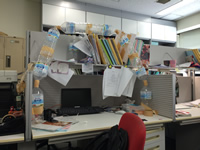
Being Creative in the Lab: This picture is of the desk of one of the graduate students in my lab. In our free time we usually find ways to pass time either by reading books, playing games, or by just being creative. This picture is of one of the latest projects that have been going on in my lab.
I can say that my biggest personal accomplishment at this moment is the progress that I have made in my Japanese language studies. For the past two years I have been doing self-study of Japanese through various textbooks and websites. However, prior to coming to Japan, I never had an opportunity to actually practice my Japanese. During the pre-departure program at Rice University I felt that I performed far less than what my expectations were for the Japanese language proficiency test. Now that I have lived in Japan for about a month and a half now, I feel as though my progress in Japanese has increased drastically. Now I am capable of maintaining conversations in Japanese with several of my lab members and comprehending some conversations between people in Japanese. It is amazing how my time in Japan has allowed my two years of language study to miraculously culminate into astounding progress in understanding and speaking Japanese within a few weeks of my time in Japan.
At this point I still think that my biggest personal challenge has been trying to meet Japanese people in Tokyo. Aside from my lab mates at the Tokyo Institute of Technology and the KIP students that I met during the NanoJapan orientation program in Tokyo, I actually haven’t met many Japanese people during my time in Tokyo. This fact is rather bothersome to me considering that I would like to make several Japanese friends during my time in Japan. Anyway, I’ll keep trying to see what I can do or change on my part.
As far as my research is concerned, I think I am making good progress at the moment. At this moment I think it is critically important that I develop a stronger understanding of the theoretical concepts behind my research before the research presentations are held. As such, I am studying more about the transport mechanisms in SWCNT films that occur at low temperatures.
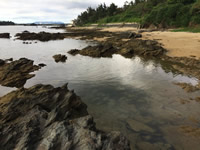
Exploring Okinawa During the Mid-Program Meeting: During the time that I had at various beaches in Okinawa, I did a lot of exploring. After climbing a few rocks on the beach I took this picture at a beach near the Okinawa Institute of Science and Technology Graduate Univeristy (OIST). It was really nice to be able to enjoy the nature of Okinawa and relax.
Research Update
This past week Taneli and I took a few measurements in the lab. We were concerned with observing the resistance dependency on temperature from 3K to 20K. After getting back our measurements we ran into a problem. By analyzing the measurements, Taneli noticed that the data points from the measurements did not have a constant offset. This inconsistent offset is a problem considering the fact that it has a significant presence at low temperatures.
In addition to this, we encountered another setback. When we compared our most recent measurements with a series of measurements that were performed with the same conditions earlier in the year, they failed to be the same. In fact, they varied significantly. This occurred while we were taking measurements for the resistance at different temperature values. That being said, we cannot begin to take measurements involving THz waves until this problem is resolved.
Given the time restraints until the research presentation, my mentor and I agreed that it is critically important for me to have a solid understanding of the theoretical concepts underlying the research. As such, I am currently spending a lot of my time reading more about transportation mechanism theory in relation to SWCNT films. Hopefully, if I am able to gain a better understanding of the core concepts behind the research, I’ll be able to contribute more to the research experiments and data analysis.
Most of my experience learning Japanese following the conclusion of the orientation program in Tokyo has been through reading a book about Japanese grammar and practicing reading and writing kanji. This is also how I have been studying Japanese during my time with the Kawano lab. At the end of the orientation program I had enough familiarity with actually speaking Japanese that I found myself to be somewhat prepared to engage in conversations in Japanese. The problem that plagued me then, and sometimes even now, is that my current knowledge of Japanese vocabulary does not include technical vocabulary. The majority of my current vocabulary is general vocabulary for a wide variety of subjects. As such, once my conversations in Japanese become more technical and focus on a subject in more detail, I have found it harder to fully understand the conversation. Even now I think that my continued studying of Japanese through my Genki textbook has been the most effective method for me to continue studying Japanese.
Perhaps the most challenging linguistic experience that I have had so far occurred when I was trying to get a haircut in Hiyoshi, Kanagawa-ken. Given that I had been Japan for about a month and a half without getting a haircut, I had a small afro at the time. Anyway, I tried communicating to the two people working there that I wanted to get my hair trimmed, not cut. Needless to say, I had trouble communicating this to them in Japanese. After a while I had to show them pictures of the hairstyle that I was trying to communicate from google. After several minutes of confusion, I was finally able to convey what I wanted to them. Fortunately, we all found the confusion to be rather funny.
One thing that I feared before coming to Japan was that my understanding of Japanese would never be sufficient enough for me. My time in Japan has confirmed this. I am always finding something new to learn about the Japanese language and feel that one can never know enough of the language. Although this mindset breeds determination in learning the language, it also breeds to some degree, a sense of dissatisfaction. As such, my experience in Japan has inspired me to keep learning more of the language so I can fluently communicate with native speakers and learn more about Japanese culture through the subtleties of the language.
I plan to continue studying Japanese culture through the Japanese major that is offered at my home university. At the moment I am unsure as to whether or not I will take the Japanese language classes offered at my school even though they are required for the major. I am currently thinking about continuing my own self-study of Japanese for two main reasons. First off, I feel that there is a greater sense of satisfaction and importance when one takes the initiative to learn a language on their own. Secondly, if I were to self-study well enough to place out of the language classes at my school, I would be able to fill my semesters with other classes that I need to graduate on time. Considering that I am planning to double major in both Physics and Japanese, it would be helpful to use those class slots to take classes mandatory for graduation. Regardless, I want to continue to use the language by participating in clubs at my school that are centered around Japanese culture and the language.
Mid-Program Meeting Reflection: For me, the Mid-Program Meeting was a good time for me to be able to reflect back upon my experience in Japan and what I plan to do when I return to the U.S. Additionally, the Mid-Program Meeting reminded of how just how quickly my time in Japan is passing. As such, for the rest of the summer, I plan to take the time to explore more of Japan outside of Tokyo and spend more time with the friends that I currently have in Japan.
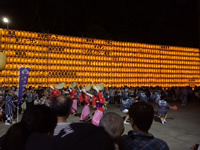
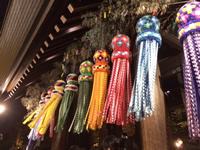
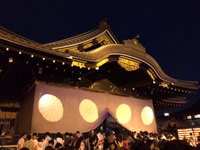
Mitama Matsuri: All three of these pictures are from the Mitama Matsuri that’s held in Tokyo from July 13th 16th. I went to the festival with one of my lab mates on Sunday and we spent several hours at the festival. Additionally, we also visited Yasukuni Shrine, a place that has become controversial in Japan’s international relations due to its relation to WWII and the Japanese soldiers who died in the war serving their country
Research Update
Progress: Yesterday I observed Taneli while he performed a few measurements with the THz detector device. For these experiments he measured the resistance response of the THz device at about 3K. To compare the device’s response to THz illumination, measurements were taken when the device was both unilluminated and illuminated by the THz wave. Since Taneli had previously performed this experiment with a THz wave with a frequency of 2.52THz, this experiment was performed with a THz wave with a frequency of 3.1THz. At the moment, Taneli is particularly interested in how the device’s resistance changes in the 3K-4K temperature range, this also includes how it responds to THz waves at these temperatures.
Problems: As mentioned in a previous report, Taneli wanted to observe the time-domain response of the THz detector device at low temperatures. However, he noted that the amplifier used in the circuit made it difficult to analyze real time data due to its time delay during amplification. An alternative method that Taneli suggested would be to generate a very small current through the circuit but he mentioned that it would be difficult to generate the current needed. As such, he will consult with Kawano-sensei about this issue.
Another issue that we encountered during measurements yesterday is the constant oscillation of the power value generated by the THz wave. In order to perform a comparative study between the THz power and device response we tried to generate a THz wave with more power. During this process, the constant fluctuation of the power generated by the THz wave became a nuisance when we tried to find a relatively stable value for the power. Since we were dealing with a THz wave generating power at about 3 mW, the slight oscillations in the power were considered to be significant to our data. Since the oscillations in power could be caused by a variety of factors (such as slight changes in the FIR laser air pressure), it took some time for us to be able to find a stable power value for the measurements.
The provided articles were a series of articles regarding Haruko Obokata’s results with her stem-cell research and allegations that she had falsified and altered data and images that were to be published in scientific journals. Obokata is a female, Japanese scientist who serves as a stem-cell researcher at the RIKEN center for Developmental Biology in Kobe, Japan. The provided articles covered the repeated speculation of the validity of her results and what her intentions may have been in doing so. Amidst the allegations, Obokata repeatedly denied the accusations of falsification and reasserted that she possessed no devious intent in the data being claimed to be falsified. However, as more coverage emerged about the issue, she was reported as saying that the falsified data was merely a mistake or an alteration that she had made without any devious intent. Regardless, after several allegations and repeated pressure to verify the validity of her results, she publicly apologized for the confusion regarding the research and upheld that she could verify the results and her method if she is given access to her lab at RIKEN again. However, one issue that is of major concern is that although several scientists have tried to replicate her results, none have been able to do so successfully. Regardless of the claims being made on either side, the fact that her experiments have not been able to be successfully replicated is troubling because the validity of experiments is dependent upon the fact of whether or not they can be successfully repeated under the same conditions by another party. Ultimately, she was found to be guilty of scientific misconduct and Obokata is in the process of appealing the judgment.
There are several speculations as to why her results may have been falsified. Given the fact that she is a female, Japanese researcher in Japan; a country where 6 out of 7 researchers are male; there could have been several societal pressures that influenced her to intentionally misrepresent her data if she actually did so. These reasons could range from trying to solidify her name as a competent, respectable female researcher in Japan or rushing to publish a scientific paper due to pressure from peers and the importance that is placed on publications in the Japanese scientific community.
Oda and Kawano Group Summer Party: This picture is of the Zushi Marina resort in Kamakura, Japan. In the picture you can see one of my lab mates, Ihara-san. I took this picture during the Oda & Kawano group lab party. Oda-sensei has been holding these summer parties for about three decades throughout his time as a professor at the Tokyo Institute of Technology. After eating dinner and spending time talking to each other, there were also fireworks at the end of the party.
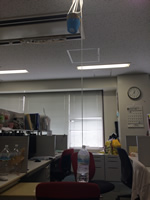
Another Day in the Lab: So, this picture is some kind of contraption that I found in the lab today (today is Sea Day 海の日). I’m not really sure what it is though…Anyway, it’s right behind my desk and I’m under the impression that it’s some kind of prank.
Research Update
At the moment I do not have any new results or progress to report on as far as my research is concerned. I plan to report back to Taneli to check on the progress of the experiments and data analysis tomorrow. I went to Osaka this past weekend and I believe that Taneli took a few more measurements in the lab while I was gone. As such, I may have more data to report on tomorrow. Either way, I believe that we are still gathering data on the conductivity response of our aligned SWCNT device when it is illuminated by THz waves of varying frequencies and power. Given the short amount of time until the scientific presentations that are part of the NanoJapan program, I will also be consulting with Taneli and Kawano-sensei this week for guidance on my research project abstract and poster presentation.
I think that if I were to pursue a research career in Japan instead of the US a few key differences or cultural norms that I would need to keep in mind are the group mentality of the lab, expected commitment to the lab and its activities, and the hierarchal system that pervades the social interactions between students and professors. Of course, these traits and how prevalent they are depend on the individual nature of each lab. Given that my lab at Tokyo Tech is very international, I have noticed aspects of my lab that resemble the Japanese lab culture and some that do not. Since I have been staying in the lab later these past few weeks, I have noticed that several of the Japanese members in the lab tend to stay at the lab until it is very late. However, a few Japanese students in the lab also leave the lab relatively early (e.g. 5pm) for various reasons. I am not sure if I can say that my lab at Tokodai is purely Japanese because I believe that it is made up of an interesting mix of international mentalities and norms. Regardless, it makes for an interesting environment to work in.
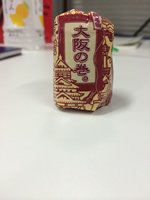
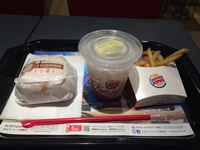
Photos from Osaka: These are two photos from my time in Osaka. While I was walking around Ame-Mura (Namba) I happened to find a Burger King. Needless to say, I had to try their teriyaki burger and sparkling acai soda. The picture on the left is from an omiyage that I bought for my lab back in Toyko, they’re called Osaka rolls if I recall correctly. Anyway, Osaka was a really fun place to visit during my time here in Japan. I’m really excited to go back there some day.
Research Update
At the moment I do not have any new data to report on. For the first half of this week the cryostat is being used by another professor so we will not be able to take measurements until either this Wednesday or Thursday. At the moment Taneli is planning to take more measurements comparative measurements for the induced photoconductivity caused by THz waves of varying frequencies. One problem that stands in the way right now is the low power of the THz waves that we are using. Given that we wish to perform a comparative study, it is imperative that the power values of each THz wave are distinguishable. By this I mean that they are not relatively close to each other in value. However, I believe our current problem is that it is difficult to amplify the power of the THz waves for the frequencies that we are using. Also, given the short amount of time remaining until my presentation date and Taneli’s thesis submission I also believe that we will not have sufficient time to investigate the time-domain response of the device during THz illumination.
What has changed the most about your perceptions and attitudes towards Japan?
I don’t think that my perceptions of Japan have changed. If anything is different about my attitude towards Japan it’s that I want to go back with an even stronger desire than I had when I initially came.
What has changed the most about your perceptions and attitudes towards the US?
My perceptions towards the US however, have changed quite a bit during my time in Japan. Right now, I am more critical of US customs, traditions, and beliefs. Of course, this is not to say that I have developed a dislike towards the US. I think that I am just keener to try to understand the motivations and behaviors that drive US culture and traditions; whether it is for the better or the worse is up to interpretation. It shouldn’t come as a surprise that this is something that I have been giving a lot of thought to recently and am still in the process of figuring out my stance on the issue.
What has changed, if anything, about you personally? Are you a different in any way from when you first came to Japan?
I can confidently say that I have changed through my experiences in Japan. However, I have yet to pinpoint exactly how. I am in the process of reflecting upon my experiences in Japan and have yet to come to a sound conclusion on this matter. The fact that I mentioned earlier that I am keener to be critical of US customs and beliefs is one way that I know I have changed so far.
What were the most common daily frustrations you experienced with living in Japan? What did you learn from these experiences?
During the time that I was living in Tokyo, Japan, I don’t think that I had any common daily frustrations. The only thing that concerned me a few times during my stay in Tokyo was that I found it a little difficult to go out and meet new people. Aside from this, I enjoyed my time living in Tokyo.
What will you miss most about living and working in Japan?
I am confident that the thing that I will miss the most about Japan is the lab group dynamic. More specifically, I am going to miss my lab members at the Tokyo Institute of Technology. I particularly enjoyed the lab dynamic that I experienced at Tokodai because most of the people in the lab enjoyed spending time together, going out to lunch, and being open with each other. As such, I really enjoyed being integrated into their lab dynamic. About each day we went out to eat lunch together and on some days I took random breaks to play soccer with other members of the lab. So, without a doubt, I know that I will miss the camaraderie and cohesiveness of the lab culture that I experienced at Tokodai.
How did this experience affect your attitudes towards academic research and your career goals?
At the moment I am still trying to figure out what my stance is on research. After my experiences in the Kawano lab, I think that I can say that I am not particularly interested in doing research where measurements are the focus. Strangely enough, I enjoy interpreting and analyzing data. For example, I enjoyed trying to understand the data that we had obtained from the experimental measurments. I enjoy trying to figure out why particular things occur and the amount of knowledge that I can gain from trying to understand this. It is just the measurement process that fails to generate a lot of interest in me. Subsequently, I am starting to think that working in a fabrication lab may be something that I will enjoy. At the moment, the idea of building devices and testing them appeals to me. So, I think that in my future research experiences I will see if I can participate in a research project with an emphasis on device fabrication.
Describe your final week in the lab.
Unfortunately, I did not have any particular arrangements made to say goodbye to the lab. I did express my thanks to the lab at the end of the weekly research meeting held each Friday during my last week in the lab though. Fortunately, a few of the other members of my lab decided to hold a going away party for me on that Friday. That was a very enjoyable experience and I know that I will miss my lab while I am away from Japan.
How did you close out your research project and do you plan to remain in contact with your research group and/or host? Do you plan to continue this research project or research in a related area upon your return to your home university?
I don’t think that there was a particular need for me to close out my research. The fact that I was creating a poster detailing the research I was working on seemed to be enough closure for the research. Anyway, I plan to stay in touch with the Kawano lab while I am away from Japan. However, I do not believe that I have any plans to continue the research that I was assisting with at Tokodai when I return to my home university.
What are your plans for your final weekend in Japan?
For my final weekend in Japan I made a point of spending time with the friends that I had made at Tokodai. As such, I went to the Itabashi fireworks show and the Pokemon Café with a friend of mine.
NanoJapan Research Symposium in Tokyo
During the Tokyo symposium I presented my research with one of my mentors from the Tokyo Institute of Technology, Tomoyuki Hirano. Instead of presenting my poster, I talked about the key points of my research project; primarily the objectives, methods, and future outlook of the project. After talking about our individual research projects, Hirano-san and I talked about what it was like working and spending time in the Oda & Kawano lab. Although the program lasted for a few hours it went by pretty fast in my opinion. For me the main takeaways were the information presented on other undergraduate research opportunities in Japan and graduate studies in Japan since I am very interested in returning to Japan for research.
Final Research Project Overview
Research Project Title: ![]()
Host Lab: Oda - Kawano Lab, Prof. Yukio Kawano, Tokyo Institute of Technology
Research Mentors: Taneli Juntunen and Tomoyuki Hirano
Objective:
What We Aim to Accomplish:
Research Methodology:
Equipment Used:
Results: No new findings in my possession. Do have older data taken that reveals some behavior that is listed in the discussion. However, it is not enough for a comprehensive comparative analysis yet.
Analysis:
Future Research:
To my parents I would say that the NanoJapan Program really helped me solidify my desire to go to school in Japan. Prior to the NanoJapan Program I was rather unsure as to whether or not I would actually like to go to school in Japan. However, after my experiences in the NanoJapan program I can confidently say that I have figured out my next academic goals; to return to Japan to do research again during my undergraduate career (but this time for an extended amount of time; ideally a year), identify a Japanese university that I want to attend, and do my best to be able to go to graduate school in Japan.
From my experience I would say to a professor that the most important thing I learned is what kind of lab environment I need to perform well in. In addition to that, I believe I identified what kind of research I would like to do. At the moment I think that I would like to do research where I can build some sort of device or sample to achieve some task. As such, when I return to my research lab in the United States I plan on seeing if I can start working in the lab instead of just doing simulation software. I’d really like to be able to work with the devices that we use in a hands-on fashion. I also learned that I like to analyze data because I can learn new concepts by trying to understand the results of a particular measurement. However, I realized that I am not particularly interested in the measurement process itself. Therefore, I think that I would really like a research project with an emphasis on device fabrication. After the fabrication of the device, I think that data analysis would help give me a greater understanding of how the device works and that would interest me very much.
When speaking with an employer I would say that the most important thing I learned from NanoJapan is the benefits of working in an international lab setting. The Oda & Kawano lab had a good number of international students so I was able to experience what it was like to work in an international lab. To me, the three most important things that I observed from working in an international lab setting are: learning and seeing differing viewpoints on the same subject, trying to understand how other interpret and understand situations, and interacting with people with experiences and outlooks on life that most likely different that one’s own experiences.
To a student at my university I would say that the most important part of the program was the opportunity to be able to interact with people in a foreign country in both a social and academic setting. The opportunity to be able to work in a professional Japanese lab is a key component of the NanoJapan program that would be difficult to replicate through most other programs. As such, I’d say that the NanoJapan program is a very eye-opening experience due to how it blends the opportunities to be able to participate in both social and professional academic settings in a foreign country. I say this because I feel that I changed a lot as a person based off the social interactions that I had in various settings in Japan.
The final, burning question that I still have about Japan is: Where can I find an all you can eat sushi restaurant?